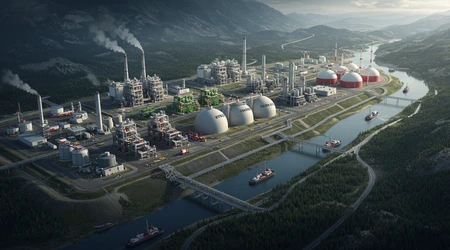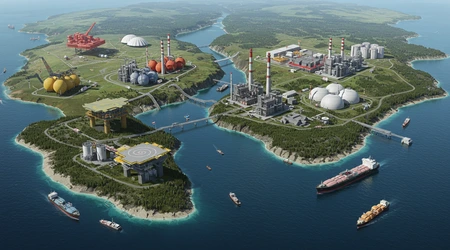Canada’s Bid to Become an LNG Superpower: Opportunities and Hurdles

Canada’s bid to become an LNG superpower marks a pivotal moment for the nation’s energy sector, with global eyes on its Pacific coast.
The recent launch of LNG Canada’s Kitimat facility, a $40-billion venture, signals Canada’s intent to rival giants like Qatar and the U.S. in liquefied natural gas exports.
This ambition, fueled by rising global demand, particularly in Asia, could reshape Canada’s economy and energy diplomacy.
Yet, the path is fraught with challenges regulatory complexities, environmental concerns, and fierce competition.
This article dives into the opportunities and hurdles, exploring why this moment matters and what’s at stake for Canada’s energy future.
The global energy landscape is shifting, and Canada aims to seize this opportunity. With the U.S. dominating LNG exports, Canada’s strategic position offers a chance to diversify markets.
The Kitimat terminal’s first shipment to Asia in June 2025 underscores this potential, cutting reliance on U.S. pipelines. But can Canada overcome its internal obstacles to claim a top spot?
This piece unpacks the economic promise, environmental debates, and geopolitical stakes, offering a clear-eyed look at Canada’s bid to become an LNG superpower.
Economic Opportunities in LNG Expansion
The economic upside of Canada’s bid to become an LNG superpower is immense, promising jobs and revenue. The LNG Canada project alone employed 50,000 workers during construction, boosting local economies in British Columbia.
Now operational, it supports 350 permanent jobs and generates billions in export revenue, with Asia as a key market.
Canada’s vast natural gas reserves, the world’s fifth-largest, provide a stable supply for decades, positioning it as a reliable global supplier.
Beyond Kitimat, projects like Woodfibre LNG and Cedar LNG, slated for 2027-2028 completion, could attract $109 billion in investments, per industry estimates.
++ U.S. Airstrikes in Iran: Canadian Reactions and Security Concerns
These facilities promise to diversify Canada’s export markets, reducing dependence on discounted U.S. sales.
For communities like Kitimat, LNG infrastructure means new schools, hospitals, and businesses, revitalizing regions long reliant on declining industries like forestry.
Small businesses in northern B.C. are already reaping benefits. Take Coastal Brew, a Kitimat-based craft brewery that expanded its operations to serve LNG workers, doubling its revenue since 2023.
Such stories highlight the ripple effect of LNG projects, fostering economic resilience in remote areas. With global LNG demand projected to grow 50% by 2030, Canada’s timing couldn’t be better to capture market share.

Geopolitical Advantages and Trade Diversification
Canada’s bid to become an LNG superpower strengthens its geopolitical hand, offering energy security to allies. Countries like Japan, South Korea, and Germany, wary of Russian gas since 2022, see Canadian LNG as a stable alternative.
The Kitimat terminal’s Pacific access slashes shipping times to Asia compared to U.S. Gulf Coast routes, giving Canada a competitive edge. This strategic positioning enhances trade ties with Asia, a region hungry for cleaner energy.
Diversifying away from U.S. markets is critical. Currently, Canadian gas sells at a discount less than half the U.S. benchmark price due to limited export options. LNG exports to Asia could narrow this gap, boosting producer profits.
Also read: Canada Hosts 2025 G7 Leaders’ Summit in Alberta
For example, the Coastal GasLink pipeline, feeding LNG Canada, ensures Canadian gas reaches global markets at premium prices, enhancing economic sovereignty.
Imagine Canada as a chess grandmaster, moving its LNG pawn to checkmate reliance on a single market.
This strategic pivot not only secures trade partnerships but also elevates Canada’s role in global energy security, making it a trusted partner in a volatile world.
Environmental Challenges and Public Perception
Yet, Canada’s bid to become an LNG superpower faces fierce environmental pushback. LNG production, from extraction to shipping, emits significant greenhouse gases, undermining Canada’s 2030 climate targets.
Critics argue LNG’s “bridge fuel” label meant to replace coal is misleading, as lifecycle emissions can rival coal’s in some cases. Environmental groups, like the Pembina Institute, estimate LNG Canada’s emissions at 4 million tonnes annually, challenging net-zero goals.
Public perception is another hurdle. In B.C., protests by Indigenous and environmental groups highlight concerns over pipeline routes and habitat destruction.
The Coastal GasLink pipeline faced blockades, delaying construction and raising costs. These tensions underscore the need for meaningful Indigenous consultation, as seen with the Haisla Nation’s support for LNG Canada, which secured community benefits.
Read more: The Most Important Rights Every Canadian Should Know
The debate isn’t black-and-white. LNG may reduce global coal use, but at what cost to Canada’s ecosystems?
Balancing economic gains with environmental stewardship remains a tightrope walk, demanding innovative solutions like carbon capture to maintain public trust.
The Woodfibre LNG project, aiming for net-zero status by 2028, offers hope. By using hydroelectric power, it could set a precedent for greener LNG production, addressing critics while advancing Canada’s bid to become an LNG superpower.
But scaling such technologies requires hefty investment and political will, both in short supply.
Regulatory and Competitive Hurdles
Navigating Canada’s regulatory maze is a formidable obstacle in Canada’s bid to become an LNG superpower.
Past projects, like the dozens canceled in B.C. during the 2010s, fell victim to stringent environmental reviews and commodity price crashes.
While reforms have streamlined approvals, critics like Conservative MP Ellis Ross argue the government’s rhetoric lacks sincerity, slowing progress. Regulatory delays can deter investors, who favor faster-moving markets like the U.S.
Competition is another beast. The U.S., the world’s top LNG exporter, boasts lower costs and established infrastructure, with projects like Venture Global LNG nearing completion. Qatar and Australia also dominate, leveraging economies of scale.
Canada’s high production costs and policy risks such as potential carbon taxes make it a less attractive bet for some investors, as noted by Wood Mackenzie’s Ed Crooks.
Here’s a practical example: a Calgary-based energy firm, frustrated by B.C.’s permitting process, shifted investment to a U.S. Gulf Coast project in 2024, citing faster approvals.
Canada must simplify regulations without compromising standards to stay competitive. The table below highlights key competitive factors:
| Country | LNG Export Capacity (2025) | Key Advantage | Key Challenge |
|---|---|---|---|
| Canada | 14 mtpa (LNG Canada) | Pacific access to Asia | High costs, regulatory delays |
| U.S. | 90 mtpa | Established infrastructure | Longer shipping to Asia |
| Qatar | 77 mtpa | Low production costs | Geopolitical tensions |
| Australia | 88 mtpa | Proximity to Asia | High labor costs |
Infrastructure and Investment Needs
Building the infrastructure for Canada’s bid to become an LNG superpower demands colossal investment.
LNG Canada’s $40-billion price tag, the largest private-sector investment in Canadian history, underscores the scale.
Future projects, like LNG Canada’s potential Phase 2 expansion to 28 mtpa, require similar funding, straining public and private resources. Securing capital in a volatile market is no small feat.
Pipelines like Coastal GasLink, which employed 25,000 workers, are critical but face logistical challenges. Harsh B.C. terrain and weather complicate construction, driving up costs.
The 670-km pipeline’s completion in 2024 was a triumph, but future projects need faster timelines to compete globally, as Gary Mar of the Financial Post argues.
Private investment is pivotal, yet global oversupply risks loom. With Asia showing signs of LNG saturation, as noted by The Canadian Press, Canada must act swiftly to lock in long-term contracts.
Strategic partnerships, like LNG Canada’s with Shell, Petronas, and Mitsubishi, offer a blueprint for balancing risk and reward.
Indigenous Partnerships and Social Impact
Indigenous partnerships are central to Canada’s bid to become an LNG superpower, blending economic and social goals. The Haisla Nation’s support for LNG Canada brought jobs, training, and revenue-sharing, setting a model for collaboration.
Over 2,000 Indigenous workers contributed to the project, fostering skills and economic empowerment in communities long marginalized.
However, not all Indigenous groups are on board. The Wet’suwet’en Nation’s opposition to Coastal GasLink sparked nationwide protests in 2020, highlighting the need for consent. S
uccessful projects hinge on trust, as LNG Canada’s community-first approach showed, prioritizing Haisla values before construction began. This model could guide future developments, ensuring social license.
Consider the analogy of a river: LNG projects must flow with community needs, not against them, to avoid blockages. Failing to engage risks delays and lost opportunities.
Canada’s ability to scale this approach will determine whether LNG growth aligns with social justice.

Global Market Dynamics and Future Outlook
The global LNG market is a high-stakes arena where Canada’s bid to become an LNG superpower must navigate shifting currents. Demand is rising BP’s 2025 Energy Outlook predicts a 25% increase in Asian LNG imports by 2035 but oversupply risks loom.
Canada’s late entry, compared to the U.S.’s 15-year head start, means it must carve a niche quickly, leveraging proximity to Asia.
Price volatility is a concern. Canadian gas trades at $2/MMBtu below U.S. benchmarks, but LNG exports could lift prices, benefiting producers.
Ninepoint Partners forecasts a $1.10-$1.30 discount by 2026, assuming capacity grows. Yet, without long-term contracts, Canada risks being squeezed by cheaper suppliers like Qatar.
What will define Canada’s success? Innovation, like Woodfibre’s net-zero goal, and diplomatic trade deals could tip the scales.
Canada must move decisively, blending ambition with pragmatism, to secure its place in the global LNG hierarchy.
Conclusion: Balancing Ambition with Reality
Canada’s bid to become an LNG superpower is a bold vision, brimming with economic and geopolitical promise. The Kitimat terminal’s first shipment marks a historic step, opening doors to Asian markets and reducing U.S. dependency.
With $109 billion in potential investments and projects like Woodfibre and Cedar on the horizon, Canada’s natural gas wealth could drive prosperity for decades.
Yet, the hurdles environmental concerns, regulatory delays, and global competition demand strategic finesse.
The path forward requires balancing economic ambition with environmental and social responsibility. Indigenous partnerships, like the Haisla Nation’s, show how collaboration can align growth with equity.
Canada stands at a crossroads: will it seize this moment to redefine its energy future, or falter under the weight of its challenges? The world is watching, and the stakes couldn’t be higher.
Frequently Asked Questions
What is the significance of LNG Canada’s Kitimat facility?
It’s Canada’s first large-scale LNG export terminal, enabling global shipments and reducing U.S. market reliance, with a $40-billion investment.
Why is there opposition to Canada’s LNG projects?
Environmental groups and some Indigenous communities cite high emissions and habitat impacts, arguing LNG undermines climate goals despite its “bridge fuel” label.
How does LNG benefit Canada’s economy?
LNG projects create jobs, boost local businesses, and generate export revenue, with potential investments of $109 billion by 2030.
What are the main hurdles for Canada’s LNG ambitions?
Regulatory delays, high costs, global competition, and environmental concerns pose significant challenges to scaling LNG infrastructure.
How does Canada’s LNG strategy impact global trade?
It diversifies export markets, strengthens ties with Asia, and enhances energy security for allies like Japan and Germany.
